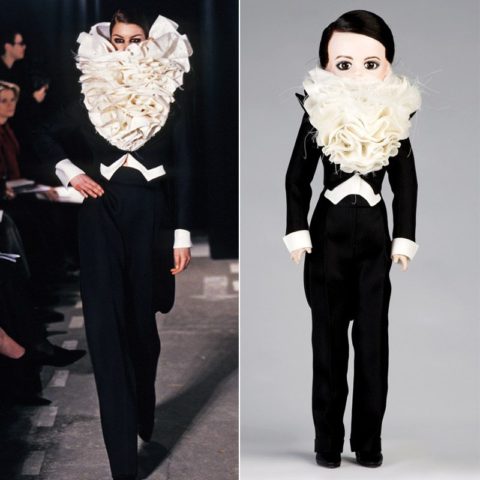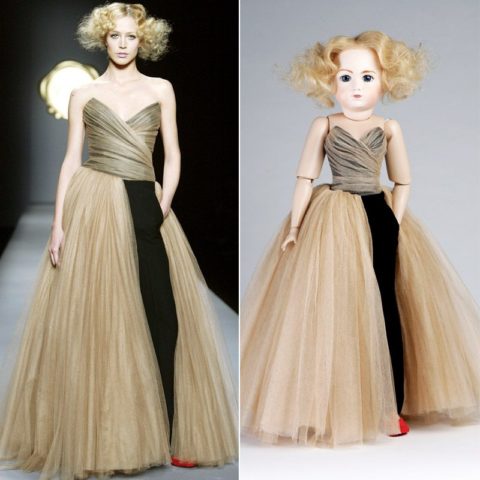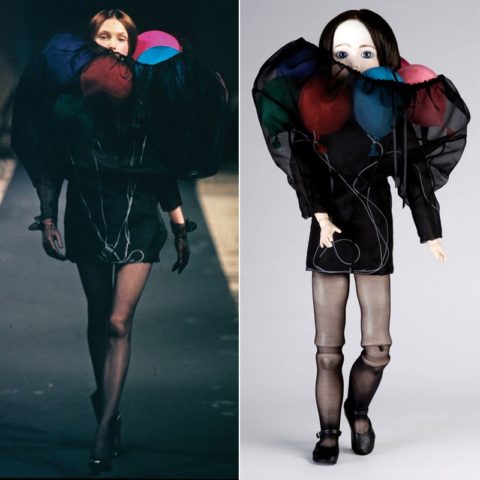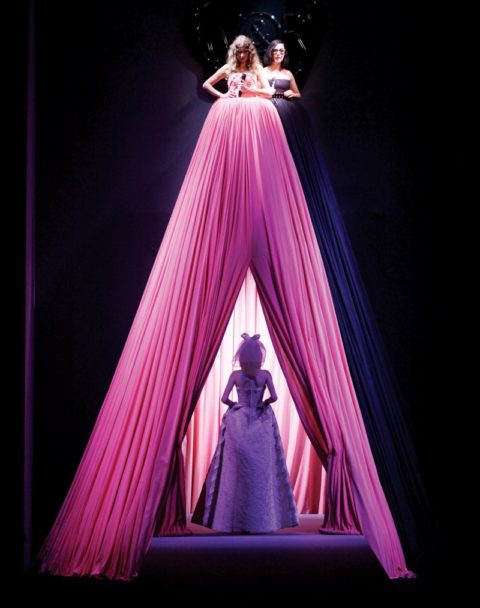We sit down with Viktor & Rolf in advance of the duo’s designer dolls exhibit at Luminato in Toronto
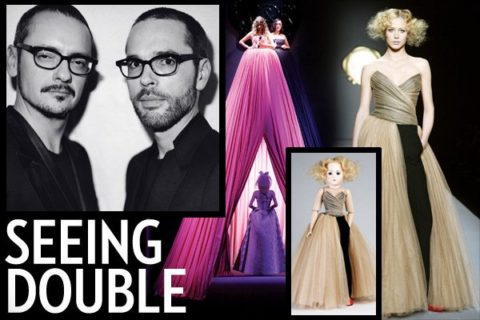
Viktor Horsting and Rolf Snoeren are mild-mannered and scrupulously polite, yet they’re anything but boring. When the three of us meet at The Room at Hudson’s Bay in Toronto (the store held a VIP cocktail party in their honour in April), the look-alike Dutch duo’s off-the-wall wit is apparent the moment seating commences, with Horsting on one side of the six-foot-plus sofa and Snoeren on the other. A perfectly executed spontaneous stunt done with mirror-like precision—that’s just how Viktor & Rolf roll.
After graduating from the Netherlands’ Artez Institute of the Arts in 1992, the designers began working together, and by the following year they had relocated to Paris to launch their collection. Known for blurring the lines between art and fashion, Horsting and Snoeren specialized in highly conceptual couture design until they shifted into ready-to-wear in 2000. Signature details like pussycat bows, shirt frills and flowered corsages brought a whiff of reality to the label’s eccentric art house-style surrealism. In Fall 2003, Tilda Swinton took the runway followed by an army of clones made up in her likeness; in Fall 2005, model Lily Cole opened their bedroom-themed show wearing built-in bedding; and in Spring 2012, Barbie-esque babes in dresses with exaggerated stitching made their runway entrance, and exit, through a larger-than-life tulle skirt-turned-curtain.
This summer, Viktor & Rolf are playing dolls again. The designers will unveil a catwalk installation of their pint-sized hand-made porcelain dolls—with each one outfitted in an exact replica of a past design—at the Royal Ontario Museum’s Big Bang Bash on June 8 as part of Luminato in Toronto. (The public exhibition runs from June 9 to 30.) Fantasy fashion with a clever twist—welcome to the V&R funhouse.
Where did the initial concept for your doll collection come from?
Viktor: “We were asked to do a retrospective at the Barbican Gallery in London [in 2008], so we made a huge dollhouse with porcelain dolls wearing all the iconic looks of our career. It was such a time-consuming project, it took years, but we loved the dolls so much that we decided to continue. Each season we make a few more.”
Growing up, did either of you have a favourite doll?
Viktor: “I played a lot with Barbies.”
Rolf: “I played with them too.” »
What are some of the challenges you’ve faced when shrinking down your designs?
Viktor: “There are so many—you have to think about the fabrics, prints, weaves, buttons. If you want to do it well, everything needs to be properly scaled down. If there is a textured fabric, it needs to be miniaturized too.”
Rolf: “Once we made a dress completely out of Swarovski stones. They don’t have those exact stones in miniatures, so you have to make everything.”
When you first brought the doll idea to your atelier workers, what was their reaction?
Viktor: “Our team likes challenges. Whenever there’s something on a technical level that they haven’t done yet they start screaming, but they love it.”
What strengths do you each bring to your ready-to-wear collection?
Viktor: “We have never analyzed that, because we know it is working. It’s like being one brain.”
Rolf: “Yes, it’s just something that works organically, and it has since day one.”
How did the idea of branding yourselves as mirror images of one another happen?
Rolf: “People asked us, ‘Who does what?’ And we always said, ‘There is no division.’ To visualize this, we wear the same glasses.”
Do you feel like you always have to be together for the brand?
Rolf: “It’s funny, when I’m alone I am less recognizable, and when I’m alone and not wearing my glasses, even less.”
You often incorporate visual puns and trompe l’oeil references in your collections. Where does this humour come from?
Viktor: “We are both very serious people, but together we become more lighthearted. We have the exact same sense of humour. In our work we try to do something that’s complex, so there is a layer of irony but it’s only one of the layers.”
Why does playing with scale and proportion interest you both?
Rolf: “We like to work on silhouettes and sculptural shapes. I think that’s our couture background. We also like surrealism, so by enlarging or miniaturizing elements, we’re playing with this idea.”
The white shirt is one of your label’s signature pieces. Why does it continue to be so appealing?
Rolf: “We like to play with classics in general, and the white shirt is such a pristine garment. Everybody knows it, so when you change something about it, it’s very understandable.”
For Fall 2013, you emphasized short silhouettes. Why does that feel fresh?
Viktor: “This is our 20th anniversary, and we did not want to do a retrospective. It feels like a new beginning. We are really drawn to things that are very youthful.”
What inspired you to take the perfume-bottle design of your fragrance, Flowerbomb, and create a new bag for fall [the Flowerbombette]?
Viktor: “The whole show was about tarnished, destroyed luxury in a very beautiful way.”
Rolf: “It’s rebel chic, so we thought something a bit ornate-like in shape went well with this theme.”
Have you ever experienced backlash based on the name Flowerbomb?
Viktor: “No, I think everybody understands that it describes optimism and beauty.”
Your set designs are often very elaborate. What do you try and communicate through them?
Viktor: “We think of a show as a performance, a way to communicate an idea, so we consider all the elements that are there to help convey the message: the decor, the backdrop, the catwalk.”
Of all the sets that you’ve dreamt up, which one has been the most memorable?
Viktor: “Well, the most difficult one was when we dressed and undressed Kristen McMenamy [in the entire collection] onstage. That could have gone horribly wrong—it was a miracle that it all worked out.”
Going forward, what direction will the brand take?
Viktor: “We are starting a bridal capsule collection. We love weddings and wedding gowns.”
What will they look like?
Viktor: “We did a lot of wedding gowns in one of our past shows that were based on a man’s shirt. We showed the evolution of it from a mini-dress to a wedding dress, so think along those lines.”
Who is your ideal bride?
Viktor: “Jessica Chastain. She was at our [Spring 2013] show, and she’s incredibly beautiful and intelligent and lovely and down to earth.”


